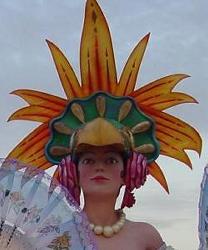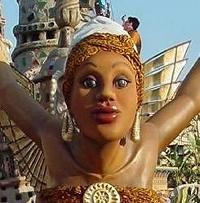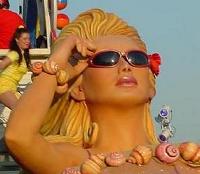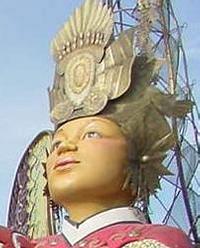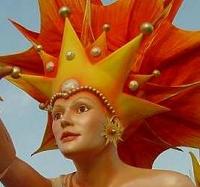An Interview With Steven Davison - Part 1
Page 2 of 4

The California Sun
Click here for a much larger version of this picture
(525 X 764, 76,529 bytes)
The Five Faces of Eureka
|
From there we kind of just started to develop things out. We started with the sun. I thought, there’s a big sun icon. There’s a Eureka icon and the major icon for the parade is that opening logo which is her as the embodiment of the sun and the energy of that golden dream. Gold is the primary color of the whole parade and it threads it. So we open with that kind of - what we call the energy of the sun or bringing that world to life. And all the logos in the opening float represent the places we’re going to head to. So we’re going to head to a kind of Pacifica thing with Eureka winding herself inside the waves. We’re going to go to Chinatown with giant dragons. So it kind of gives you a precursor and it gives you the first beat of contemporary music - something that we decided to do to create a new experience. Because my whole thing was, you go to Disneyland and you’re going to do a very specific experience. It’s all about fantasy and magic. Like "Believe.." is. "Believe..." wraps itself in that. If they asked me to do something like "Golden Dreams Fireworks" in the sky here, I would do it totally different because I would want the experiences to be different. So when you come to California Adventure it’s just wild. It’s all about that word "adventure." And we’re going to take you through this community wash thing but you’re going to have an adventure. You’re going to see stuff. It’s really going to get you excited - that was the biggest hope - you go "wow what’s that. What is this?"
So we started the Eurekas - going back. I jump around a lot. So we developed all the Eurekas. So we have the Eureka that’s the Folklorico. We have the Eureka that is that angel welcoming you into the City of Angels. We then jump into Pacifica where she’s buried in the giant sand car that kind of represents a lot of iconic things that people think about California and the beach. And then we created her as like a Chinese opera goddess as the Phoenix rising up into the sky before we end with the sun icon with her as the golden dream coming to life. Then we started to build all the community pieces.
So we worked on the parade with Michael Curry who did Lion King on Broadway and who originally did the Lion King Parade here. We worked very closely with Michael because he understands me because I’m very kind of out there with ideas and thoughts and feelings, so I can walk in and say, "can we do a Golden Gate Bridge walking down the street like Chinatown’s bringing San Francisco to you?" The theme was really tough. When you have to take the word California and try to iconically represent it in the parade it’s not like doing an animated film, like if we were going to do the Hercules parade or Aladdin parade. There’s a whole set of synergistic products that come along with that. California is a little different because now you’re picking things that people have to instantly understand and get. Usually, by the time a parade hits at one of the parks you know the characters, you know the style, you know the feeling. With this parade you’re starting from scratch. People have their own vision of California and what we played with was kind of a 50/50 what people expect to see and kind of the dream aspect of it. Then we did it all with that theatrical world.
Because if we truly went after the Latino community and not made it theatrical we would get broadsided because they’re all different in a sense. What we did was kind of just take pieces of it and essences of it. We always talked about the parade being a tapestry and as you went along this road that’s a tapestry you pull little threads and these little threads would be different pieces of communities. And if you look at the parade it’s 50/50. You’ll see a very kind of fantastic side of it, a theatrical side and then a traditional side. Even in Folklorico, when you enter Fiesta of the Birds you’ll see we have Folkloricos but we hyped up the color a little bit, but at the same time we have 18 foot skeletons and we did that and a lot of people were terrified of that in the beginning. "You’re going to have 18 foot skeletons? Aren’t people going to get scared?" I said, "yeah. I hope so." I said what I want is people to look at that and go "my God what are those" and start to train the cast to tell them what it is. "Oh that’s the Day of the Dead celebration" and really, it was kind of my version of "read more about it." When you see that community or even Watts Towers, I hope it really inspired people to go see the real one or read more about it or find out about that community and find out what it’s all about.
LP: You mentioned tapestry in a couple of different ways. You certainly seemed to be influenced by Tapestry of Nations, with the puppetry and the drums. Was there any direct influence there?
SD: Michael did Tapestry of Nations, Michael Curry. What I loved about Tapestry is that it kind of jumped off the page and got things to move in huge proportions without motors and that’s what I really wanted in this parade. What I pushed for was to create kind of an A-B-C kind of format. So you have these really fantastic floats coming at you but within them are pieces of puppetry or moving scenery and then costume pieces down below it so it really builds upon itself. So it’s not just one thing or two things, it’s really kind of a very harmonious design that kind of pulls at things and makes people go, "yikes, wow." It’s like "how do they do that or I never knew you could wear a costume that size."

